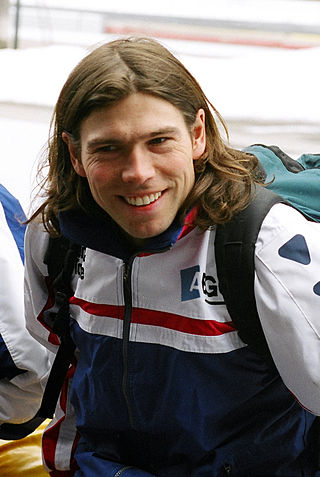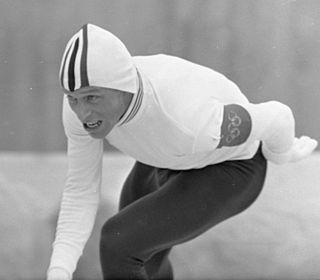
Ice skating is the self-propulsion and gliding of a person across an ice surface, using metal-bladed ice skates. People skate for various reasons, including recreation (fun), exercise, competitive sports, and commuting. Ice skating may be performed on naturally frozen bodies of water, such as ponds, lakes, canals, and rivers, and on human-made ice surfaces both indoors and outdoors.

Speed skating is a competitive form of ice skating in which the competitors race each other in travelling a certain distance on skates. Types of speed skating are long track speed skating, short track speed skating, and marathon speed skating. In the Olympic Games, long-track speed skating is usually referred to as just "speed skating", while short-track speed skating is known as "short track". The International Skating Union (ISU), the governing body of competitive ice sports, refers to long track as "speed skating" and short track as "short track skating".

Gerard Pieter Hendrik van Velde is a Dutch retired speed skater who specialised in sprinting. He won an Olympic gold medal in 2002.

Ice skates are metal blades attached underfoot and used to propel the bearer across a sheet of ice while ice skating.

Inline speed skating is the roller sport of racing on inline skates. The sport may also be called inline racing by participants. Although it primarily evolved from racing on traditional roller skates, the sport is similar enough to ice speed skating that many competitors are known to switch between inline and ice speed skating according to the season.

Figure skates are a type of ice skate used by figure skaters. The skates consist of a boot and a blade that is attached with screws to the sole of the boot. Inexpensive sets for recreational skaters are available, but most figure skaters purchase boots and blades separately and have the blades mounted by a professional skate technician.

Long-track speed skating, usually simply referred to as speed skating, is the Olympic discipline of speed skating where competitors are timed while crossing a set distance. It is also a sport for leisure. Sports such as ice skating marathon, short track speedskating, inline speedskating, and quad speed skating are also called speed skating.
Gerrit Jan van Ingen Schenau was a Dutch biomechanist. He made large contributions to the field of biomechanics, particularly muscle coordination, energetics of movement, and the functions of biarticular muscles. He focused on speed skating in particular, and played a significant part in the invention of the clap skate.

Adrianus "Ard" Schenk is a former speed skater from the Netherlands, who is considered to be one of the best in history. His first Olympic success came in 1968, when he won a silver medal at the 1968 Winter Olympics. Between 1970 and 1972 Winter Olympics, Schenk won three consecutive World Allround Speed Skating Championships. He won three gold medals at the 1972 Winter Olympics, becoming, along with Galina Kulakova of Soviet Union, the most successful athlete there.

Cornelis Arie "Kees" Verkerk is a former speed skater from the Netherlands.
The Adelskalender in skating is a ranking for long track speed skating based on skaters' all-time personal records for certain distances. As in samalog competitions, the skater's time for each distance is divided in 500 metre averages, truncated to 3 decimal places, and the results are then added up – the lower the sum, the better. The samalog system was introduced in 1928 in Norway, replacing ranking points in the traditional 4 distance championships, and can also be used to reconstruct scores based on personal records that were set before the samalog system was invented.

Tonny de Jong is a former Dutch speed skater, who was raised in Heerenveen and now lives in Calgary with Canadian speed skater Mark Knoll, whom she married in 2003.

Per Willy Guttormsen is a former Norwegian speed skater and cyclist. He was among the world's best long distance skaters in the 1960s.
Jan Maarten Heideman is a Dutch speed skater who specialises in marathon speed skating.

In ice hockey, players use specialized equipment both to facilitate the play of the game and for protection as this is a sport where injuries are common, therefore, all players are encouraged to protect their bodies from bruises and severe fractures.
Diederik Hol is a Dutch Design Engineer, designer of the Dual Box inline skate frame and the Narrow Shape Cross-Section (NSX) ice blade, and founder/director of skate company CadoMotus Skating BV.
The upright spin is one of the three basic figure skating spin positions. The International Skating Union (ISU), the governing body of figure skating, defines an upright spin as a spin with "any position with the skating leg extended or slightly bent which is not a camel position". It was invented by British figure skater Cecilia Colledge. Variations of the upright spin include the layback spin, the Biellmann spin, the full layback, the split, the back upright spin, the forward upright spin, the scratchspin, and the sideways leaning spin.
Emery Chance Lehman is an American speed skater who represented the United States at the 2014 Winter Olympics, the 2018 Winter Olympics, and the 2022 Winter Olympics. Lehman started playing ice hockey at age six, taking up speed skating in an attempt to improve his hockey at age nine.
Van Ingen is a Dutch toponymic surname meaning "from/of Ingen", a town in Gelderland. An archaic spelling is Van Inghen. People with the surname include:
Kimi Goetz is an American speed skater who represented the United States at the 2022 Winter Olympics.




![]() klapschaats ) is a type of ice skate used in speed skating. Unlike in traditional skates where the blade is rigidly fixed to the boot, clap skates have the blade attached to the boot by a hinge at the front. This allows the blade to remain in contact with the ice longer, as the ankle can now be extended toward the end of the stroke, as well as for more natural movement, thereby distributing the energy of the leg more effectively and efficiently.
klapschaats ) is a type of ice skate used in speed skating. Unlike in traditional skates where the blade is rigidly fixed to the boot, clap skates have the blade attached to the boot by a hinge at the front. This allows the blade to remain in contact with the ice longer, as the ankle can now be extended toward the end of the stroke, as well as for more natural movement, thereby distributing the energy of the leg more effectively and efficiently.










